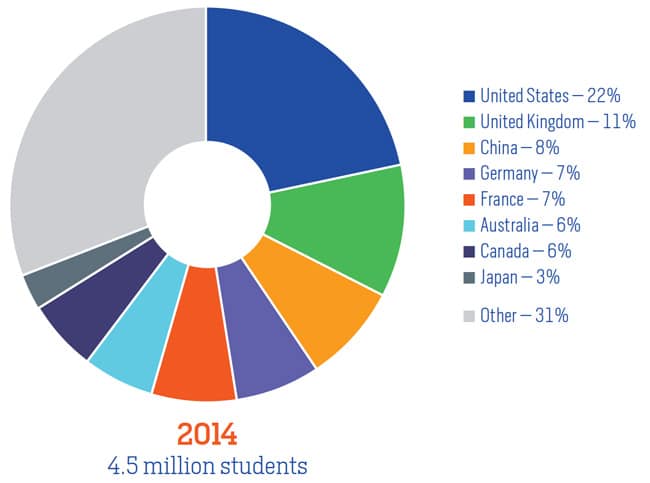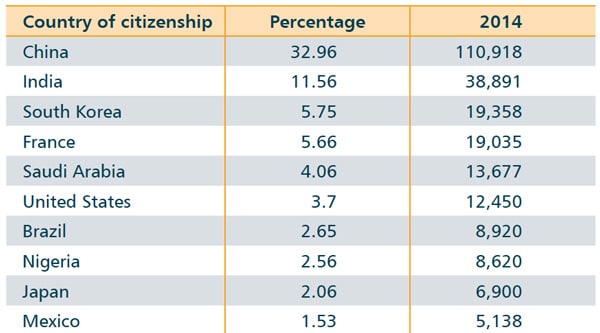Canada books another strong year of international enrolment growth
The Canadian Bureau for International Education (CBIE) released its annual report on the state of international education in Canada this week. As in previous years, the 2015 edition of A World of Learning: Canada’s Performance and Potential in International Education provides statistics and analysis on foreign student enrolment in Canada, outbound mobility, and emerging trends in international education.
The headline for this year is that the number of international students in Canada continues to increase. Based on Citizenship and Immigration Canada (CIC) data, CBIE reports 336,497 international students in Canada for 2014, representing an 83% increase since 2008 and a 10% year-over-year increase to build on 2013’s record enrolment.
(Editor's note: CBIE advises that CIC changed its reporting methodology in 2014 so that temporary residents holding both study permits and work permits were included in the enrolment counts for this year's report. In previous years, temporary residents holding both types of permits may not have been included in student counts if they spent the bulk of their time in Canada engaged in work. This change results in an increase in enrolment counts reported for 2008–2013 over those given in earlier editions of A World of Learning.)
With that clarification in mind, the following chart maps enrolment growth from 2008. Please note that in a Canadian context “study permit” is the term used to refer to study visas, and that permits are required only for students who study at any level for six months or more. The following student counts, therefore, do not reflect enrolment for language studies or any other programmes of less than six months.


- 40% intend to go on to further studies in Canada (24% at another institution; 16% at their current institution);
- 51% intend to seek permanent resident status in Canada following their studies.
The big ten
Six in ten international students in Canada are from Asia (46% East Asia; 14% South Asia). Europe and the MENA region (Middle East and North Africa) account for another 10% each, and Africa a further 7%. Markets in Latin America and the Caribbean also account for roughly 7% of foreign enrolment in Canada, while the most proximate sending market, the US, comes in at 4% for 2014.
Drilling down a bit, CBIE reports that the top five sending countries for Canada – China, India, South Korea, France, and Saudi Arabia - accounted for six in ten international students in Canada.
The top ten countries - add the US, Brazil, Nigeria, Japan, and Mexico at this point - sent 72% of Canada’s foreign students in 2014. "This proportion remains relatively unchanged from the 2012 figure of 70%," notes CBIE, "indicating that in recent years there has been little change in the representational diversity of international students in Canada."
The following table provides a breakdown for Canada’s top ten sending markets. We should note as well that just outside of the top ten are Vietnam, Iran, Pakistan, the UK, and Russia, each of which accounted for between .99% and 1.44% of Canada’s foreign students in 2014.

- China (110,918 students in 2014 and a 16% increase over 2013);
- India (38,891 and 11% growth);
- France (19,035 and 15% growth);
- Brazil (8,920 and also 15% growth);
- Nigeria (8,620 and a notable 25% increase over 2013);
- Vietnam, which sent 4,843 students in 2014 for a 16% increase over the year prior.
In contrast, three other important sending markets – Saudi Arabia, Mexico, and Iran – all declined between 2013 and 2014, by 2%, 3%, and 10% respectively.
Focus on higher education
The majority of Canada’s international students (79.8% or 268,659 students) were enrolled in post-secondary studies in 2014. Just over 52,000 (15.4%) were pursuing secondary studies, with the balance - a little less than 5% of total enrolment – in other fields of study, whether language programmes or otherwise. As noted above, these figures will naturally understate enrolment in shorter-term language programmes as those students will not have studied in Canada with a study permit for programmes of less than six months. A separate survey from Languages Canada indicates that Canada welcomed 137,416 language students in 2014. Just over a third of those (34%) held study permits, suggesting that the incremental number of language students – that is, over and above the enrolment reported by CBIE and CIC for 2014 – stands at about 90,700 for the year.
Therefore, combining the Languages Canada and CIC statistics places the total head count for international students in Canada at something closer to 427,000 for 2014.
Eye on trends
A World of Learning 2015closes by highlighting important trends in internationalisation worldwide. In terms of student mobility, two of the key trends addressed in the report are the growth of intra-regional mobility and emerging global education hubs. CBIE points back to OECD data indicating a growth trend in mobility between countries that are close to each other, and that 21% of all mobile students in 2012 were from countries that shared borders with the destination country. This pattern is playing out worldwide, and is particularly notable in Europe, where major mobility programmes play an important role, Africa, and in Southeast Asia where a Common Space of Higher Education has been established to encourage mobility among ASEAN states. One implication of this global trend for Canada, argues CBIE, is that "Canada can leverage intra-regional mobility by enhancing its efforts to strengthen education ties with the US, Mexico, Latin America and the Caribbean." The emergence of important education hubs around the world, notably in Asia and the Middle East, is another important trend flagged by CBIE. While traditional destination countries still attract the lion’s share of internationally mobile students, regional hubs are indeed drawing greater numbers and – given their success at drawing students from neighbouring countries - are something of an accelerator for the growth of intra-regional mobility as well. As for Canada, CBIE CEO Karen McBride says, "Internationalisation is no longer a peripheral activity, but a core strategy of many institutions and schools." Indeed it is and the trends we have considered here, along with the many others that shape and shift international education markets, will no doubt continue to challenge and engage international educators in Canada and around the world.















